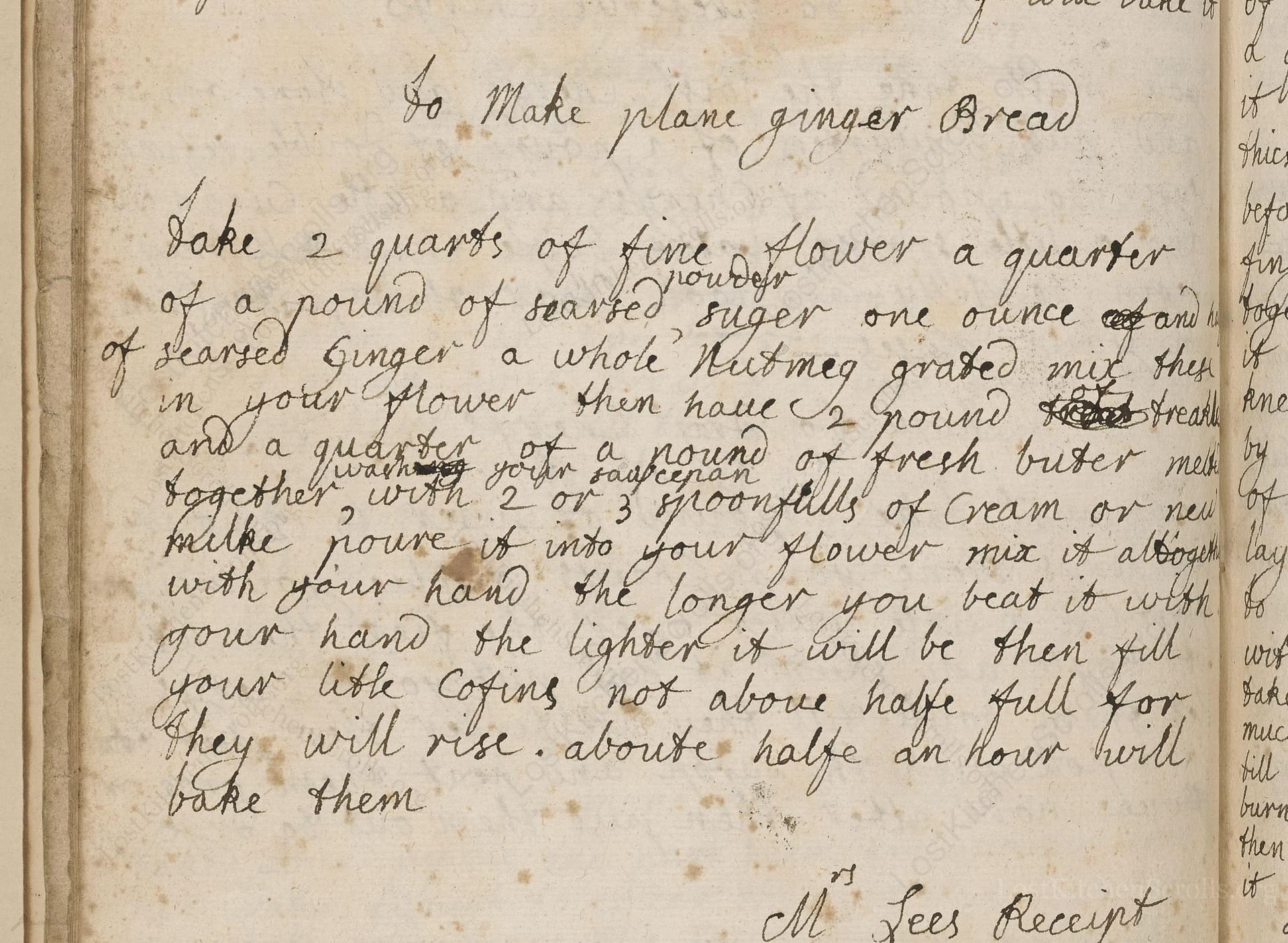To Make Plane Ginger Bread
From the treasured pages of Receipt book
Unknown Author

To Make Plane Ginger Bread
"Take 2 quarts of fine Flower a quarter of a pound of searsed suger one ounce of searsed Ginger a whole Nutmeg grated mix these in your Flower then have 2 pound treakl and a quarter of a pound of fresh buter melt together with 2 or 3 spoonfulls of Cream or new milke poure it into your Flower mix it altogether with your hand the longer you beat it with your hand the lighter it will be then fill your litle Cofins not above halfe full For they will rise. aboute halfe an hour will bake them"
Note on the Original Text
As was customary in the early 1700s, recipes were written with minimal punctuation, no lists of ingredients, and idiosyncratic spelling (e.g. 'flower' for 'flour,' 'treakl' for 'treacle,' and 'searsed' for 'sifted'). Quantities and instructions are woven together in prose, and precise measurements or oven temperatures are absent, relying on the cook’s hands-on knowledge. The term 'cofin' here is an old word for a pastry case or small mold. The recipe tells the cook to beat the dough with their hands—physical kneading was believed to lighten bread and cakes. Instructions are brief and practical, assuming a level of kitchen literacy that would be standard for experienced household cooks of the era.

Title
Receipt book (1700)
You can also click the book image above to peruse the original tome
Writer
Unknown
Era
1700
Publisher
Unknown
Background
A delightful glimpse into the kitchens of the early 18th century, this historic culinary manuscript promises a feast of recipes, remedies, and perhaps a pinch of mystery. Expect both practical fare and elegant inspiration for the curious cook.
Kindly made available by
Folger Shakespeare Library
This recipe is taken from a handwritten cookbook dated around 1700—a time when gingerbread was a popular treat in both English homes and fairs. It was valued both for its flavor and its supposed medicinal qualities, as ginger was thought to aid digestion. Baking gingerbread at the dawn of the 18th century would have been a festive affair, often associated with holidays and celebrations. Recipes like this one circulated orally and in manuscript form, well before printed cookbooks became common.

Cooks of the period would have used large wooden bowls for mixing by hand, mot long wooden spoons, and sieves made from linen for sifting flour and sugar. Heavy-bottomed pans sat over open hearths to melt butter and treacle. The 'coffins' mentioned in the recipe refer to small, box-like pastry molds or possibly wooden forms—today we’d use muffin tins or small loaf pans. Baking would be done in a wood-fired oven, with close attention paid to timing and the heat of the fire, guided by experience rather than exact temperatures.
Prep Time
20 mins
Cook Time
30 mins
Servings
24
We've done our best to adapt this historical recipe for modern kitchens, but some details may still need refinement. We warmly welcome feedback from fellow cooks and culinary historians — your insights support the entire community!
Ingredients
- 8 1/2 cups (2 lb 10 oz) plain (all-purpose) flour
- 4 oz granulated sugar, sifted
- 1 oz ground ginger (or fresh ginger, dried and ground)
- 1 whole nutmeg, grated (~0.2 oz)
- 2 lb (4 cups) golden syrup (substitute for black treacle if preferred)
- 4 oz unsalted butter
- 2–3 tbsp double cream or whole milk
Instructions
- To make this plain gingerbread in a modern kitchen, begin by sifting 8 1/2 cups (2 lb 10 oz) of plain (all-purpose) flour into a large bowl.
- Add 4 oz of sifted sugar, 1 oz of ground ginger, and the finely grated zest of one whole nutmeg.
- Mix these dry ingredients thoroughly.
- Separately, gently melt 2 lb (4 cups) of golden syrup (as a modern substitute for 2 pounds of treacle) together with 4 oz of unsalted butter in a saucepan.
- Stir in 2 or 3 tablespoons (2–3 tbsp) of fresh cream or whole milk to enrich the mixture.
- Pour the warm syrup-butter mixture into the dry ingredients.
- Using your hands, mix and knead thoroughly—the recipe asks you to work the dough well, as this will lighten the finished product.
- Spoon the dough into greased muffin tins or similar molds, filled no more than halfway to allow for rising.
- Bake in a preheated oven at 350°F for about 30 minutes, or until golden and cooked through.
Estimated Calories
350 per serving
Cooking Estimates
It takes about 20 minutes to prepare the ingredients and dough. Baking takes about 30 minutes. Each piece has around 350 calories, and the recipe makes 24 servings.
As noted above, we have made our best effort to translate and adapt this historical recipe for modern kitchens, taking into account ingredients nowadays, cooking techniques, measurements, and so on. However, historical recipes often contain assumptions that require interpretation.
We'd love for anyone to help improve these adaptations. Community contributions are highly welcome. If you have suggestions, corrections, or cooking tips based on your experience with this recipe, please share them below.
Join the Discussion
Rate This Recipe

Den Bockfisch In Einer Fleisch Suppen Zu Kochen
This recipe hails from a German manuscript cookbook compiled in 1696, a time whe...

Die Grieß Nudlen Zumachen
This recipe comes from a rather mysterious manuscript cookbook, penned anonymous...

Ein Boudain
This recipe comes from an anonymous German-language manuscript cookbook from 169...

Ein Gesaltzen Citroni
This recipe, dating from 1696, comes from an extensive anonymous German cookbook...
Browse our complete collection of time-honored recipes



